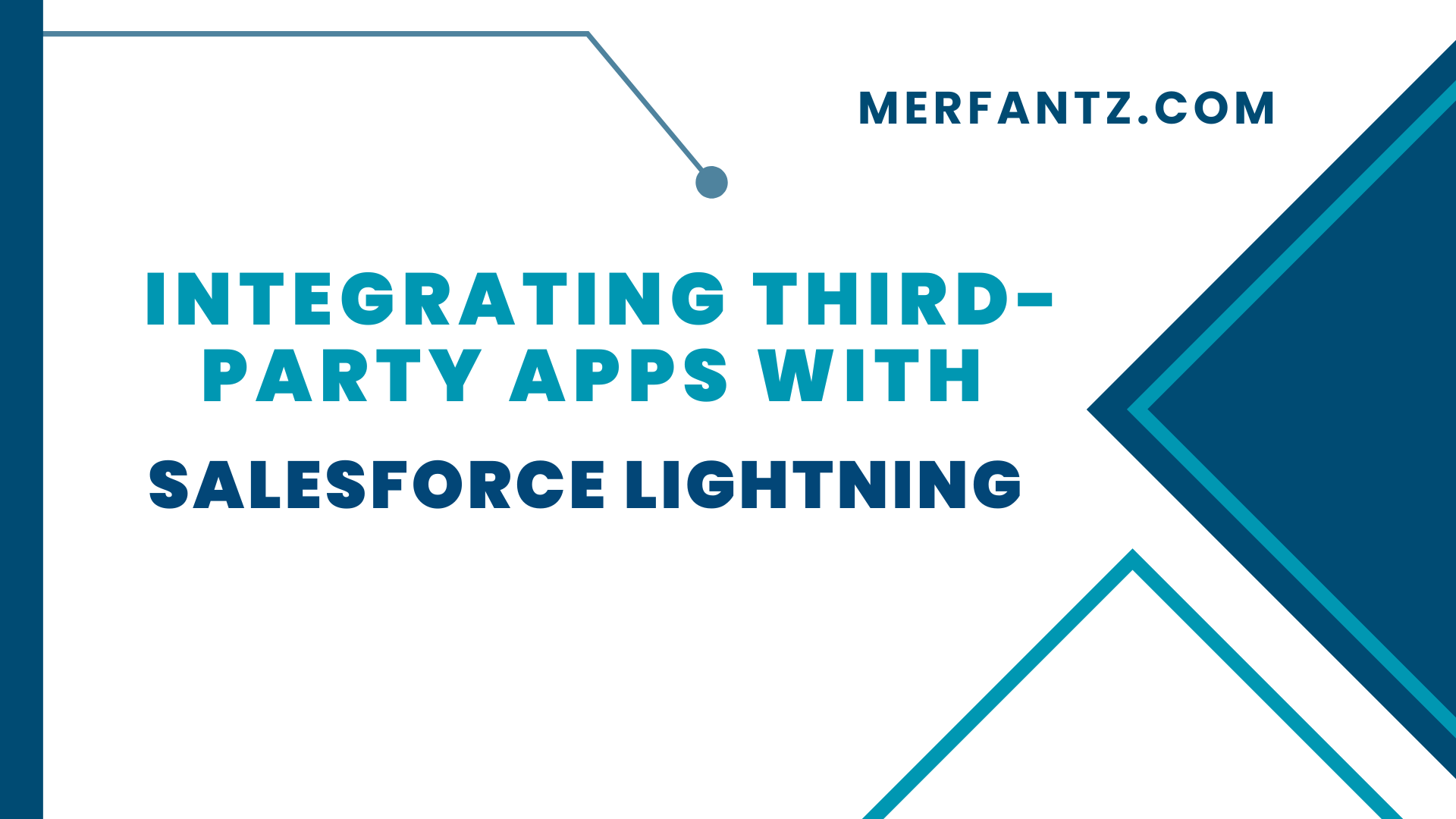Why Integrate Third-Party Apps with Salesforce Lightning?
Integrating third-party apps with Salesforce Lightning can bring numerous benefits to your business. By leveraging the power of Salesforce Lightning, you can extend the capabilities of your CRM platform and enhance your business processes. Third-party apps offer specialized functionalities that can address specific business needs, such as marketing automation, customer service management, or project collaboration. Integrating these apps with Salesforce Lightning allows you to centralize your data, streamline workflows, and improve overall efficiency.
Moreover, integrating third-party apps with Salesforce Lightning enables you to create a unified view of your customer data. With a seamless flow of information between various systems, you can gain deeper insights into customer behavior, preferences, and interactions. This holistic view empowers your sales and marketing teams to personalize customer experiences, make data-driven decisions, and drive revenue growth. By integrating third-party apps with Salesforce Lightning, you unlock a world of possibilities to optimize your business processes and deliver exceptional customer experiences.
Streamlining Business Processes with App Integrations
Streamlining your business processes is crucial for maximizing productivity and efficiency. By integrating third-party apps with Salesforce Lightning, you can eliminate manual data entry, reduce duplicate efforts, and automate repetitive tasks. For example, you can integrate your email marketing platform with Salesforce Lightning to automatically sync customer data, track email campaigns, and capture leads seamlessly. This integration saves time, minimizes errors, and allows your teams to focus on high-value activities rather than administrative tasks.
In addition to automating processes, app integrations with Salesforce Lightning enable real-time data synchronization. This means that any updates made in one system are immediately reflected in Salesforce Lightning and vice versa. Whether it’s updating contact information, tracking sales activities, or monitoring customer support tickets, real-time data synchronization ensures that your teams have access to the most up-to-date information. This promotes collaboration, improves decision-making, and enhances the overall agility of your organization.
Benefits of Salesforce Lightning Integration
Integrating third-party apps with Salesforce Lightning offers a plethora of benefits for your business. First and foremost, it enhances the functionality of your CRM platform by bringing in specialized features and capabilities from external applications. This enables you to tailor Salesforce Lightning to your specific business needs, providing a customized solution that aligns with your processes and requirements.
Furthermore, Salesforce Lightning integration allows you to create a unified and centralized view of your data. By connecting disparate systems and applications, you can consolidate information, eliminate data silos, and gain a comprehensive understanding of your customers. This holistic view empowers your teams to provide personalized experiences, improve customer satisfaction, and drive better business outcomes. Salesforce Lightning integration also enhances efficiency by automating manual tasks, reducing errors, and increasing productivity across departments.
Common Challenges in Third-Party App Integration
While integrating third-party apps with Salesforce Lightning offers significant advantages, it’s important to be aware of the common challenges that may arise during the integration process. One challenge is ensuring compatibility and seamless communication between different systems. The third-party app and Salesforce Lightning should have well-documented APIs and support the necessary integration methods to facilitate smooth data exchange.
Another challenge is managing data integrity and security. It’s crucial to establish robust data governance practices to maintain the accuracy, consistency, and privacy of the integrated data. Data mapping, validation rules, and encryption techniques can help ensure that sensitive information is protected throughout the integration.
Key Considerations for Successful Integration
To ensure a successful integration between third-party apps and Salesforce Lightning, it’s important to consider a few key factors. Firstly, clearly define your integration goals and identify the specific functionalities or processes you want to enhance through integration. This will help you select the most suitable third-party apps and streamline the integration efforts.
Additionally, evaluate the scalability and flexibility of the third-party apps. As your business grows and evolves, you need apps that can adapt and accommodate changing requirements. Consider the app’s track record, customer reviews, and the availability of ongoing support and updates. A well-established app with a strong user community and regular updates is often a good choice.
Choosing the Right Third-Party App for Your Salesforce Org
Selecting the right third-party app for your Salesforce org is crucial for a successful integration. Start by conducting thorough research and understanding your specific business needs. Identify the key features and functionalities that are essential for improving your processes and achieving your goals. Consider factors such as industry-specific requirements, user-friendliness, and integration capabilities.
Additionally, reach out to trusted sources, such as industry forums or technology consultants, for recommendations and insights. Read reviews, case studies, and testimonials to gauge the app’s effectiveness and reliability. Take advantage of free trials or demo versions to test the app’s compatibility with Salesforce Lightning and its usability within your organization before committing to a purchase.
Step-by-Step Guide to Integrating Third-Party Apps with Salesforce Lightning
Integrating third-party apps with Salesforce Lightning involves a series of steps to ensure a smooth and successful integration. Here’s a step-by-step guide to help you navigate the process:
- Define Integration Goals: Clearly outline your integration objectives and identify the specific functionalities or processes you aim to enhance through integration. This will serve as a roadmap for selecting the right apps and configuring the integration.
- Research and Select Third-Party Apps: Conduct thorough research to identify third-party apps that align with your integration goals. Consider factors such as features, compatibility, customer reviews, and support. Choose apps that have a proven track record and a solid reputation in the market.
- Evaluate Integration Methods: Assess the available integration methods supported by both Salesforce Lightning and the third-party app. Determine whether you can leverage pre-built connectors, APIs, or middleware platforms to establish a seamless connection between the systems. Choose the integration approach that best suits your technical capabilities and requirements.
- Plan Data Mapping and Transformation: Understand the data structures of both Salesforce Lightning and the third-party app. Map the data fields between the two systems and define any necessary data transformations or conversions. Ensure that the integrated data will be accurate, consistent, and aligned with your business needs.
Best Practices for Maintaining and Updating Integrated Apps
To ensure the smooth functioning of integrated third-party apps with Salesforce Lightning, it’s essential to follow best practices for maintenance and updates. Here are some key practices to consider:
- Regular Monitoring and Testing: Continuously monitor the performance and functionality of integrated apps. Regularly test the integration to identify any issues or potential improvements. This proactive approach helps catch and address problems before they impact your business processes.
- Stay Up-to-Date with App Updates: Keep track of updates released by the third-party app vendors. Stay informed about new features, bug fixes, and security patches. Updating the integrated apps to the latest versions ensures that you can leverage new functionalities and maintain compatibility with Salesforce Lightning updates.
- Data Management and Security: Implement robust data management practices to ensure data integrity and security. Regularly review and clean up data to prevent duplicates or outdated information. Establish data backup and recovery mechanisms to protect against data loss. Additionally, monitor and enforce access controls and data privacy measures to safeguard sensitive information.
- Documentation and Knowledge Sharing: Maintain comprehensive documentation of the integration setup, configurations, and any customizations made. This documentation acts as a reference for troubleshooting, onboarding new team members, and ensuring consistency in the integration process. Encourage knowledge sharing among your team to promote collaboration and foster a deeper understanding of the integration.
Partner with Merfantz Technologies for Seamless Salesforce Lightning Integration
When it comes to integrating third-party apps with Salesforce Lightning, partnering with a trusted Salesforce implementation partner like Merfantz Technologies can make a significant difference. With our expertise and experience in Salesforce solutions, we can guide you through the integration process and ensure seamless integration of third-party apps with Salesforce Lightning.
At Merfantz Technologies, we understand the complexities involved in app integration and the importance of customization to meet your unique business needs. Our team of certified Salesforce experts will work closely with you to analyze your requirements, recommend the right apps, and design a tailored integration strategy. With our dedicated support and ongoing maintenance services, we ensure that your integrated apps continue to perform optimally and drive your business forward.
FAQs about Integrating Third-Party Apps with Salesforce Lightning
What are the benefits of integrating third-party apps with Salesforce Lightning?
Integrating third-party apps with Salesforce Lightning provides enhanced functionality, streamlined processes, and a unified view of customer data. It allows you to extend the capabilities of your CRM platform, automate tasks, and make data-driven decisions, leading to improved productivity, customer experiences, and business outcomes.
How can I choose the right third-party app for my Salesforce org?
Choosing the right third-party app involves understanding your integration goals, conducting thorough research, and evaluating factors such as features, compatibility, customer reviews, and support. It’s also beneficial to seek recommendations from trusted sources and utilize trial versions to test the app’s compatibility and usability within your organization.
What challenges can arise during third-party app integration with Salesforce Lightning?
Common challenges include ensuring compatibility and seamless communication between systems, managing data integrity and security, and addressing any technical limitations or dependencies. However, with careful planning, proper documentation, and adherence to best practices, these challenges can be mitigated.
How can I ensure the successful maintenance and updates of integrated apps?
To ensure the smooth functioning of integrated apps, it is important to regularly monitor performance, test the integration, stay updated with app releases, maintain data integrity and security, and document the integration setup. These practices help identify and resolve issues promptly, leverage new features, and ensure consistent performance.
How do I integrate external apps with Salesforce?
To integrate external apps with Salesforce, you can utilize Salesforce’s robust APIs (Application Programming Interfaces) and various integration methods such as point-to-point integrations, middleware platforms, or pre-built connectors. These methods enable data exchange, functionality sharing, and seamless communication between Salesforce and external applications.
What is an example of Salesforce integration with third-party applications?
An example of Salesforce integration with a third-party application is integrating Salesforce with a popular marketing automation tool like HubSpot. This integration enables synchronization of leads, contacts, and marketing data between HubSpot and Salesforce. It streamlines lead management, automates marketing campaigns, and provides a unified view of customer interactions across both platforms.
What are third-party integrations in Salesforce?
Third-party integrations in Salesforce refer to the process of connecting external applications or services with Salesforce’s CRM platform. These integrations extend the functionality of Salesforce by leveraging specialized capabilities of third-party apps, allowing businesses to enhance their processes, automate tasks, and improve data management across systems.
How do connected apps work in Salesforce?
Connected apps in Salesforce are used to authenticate and enable secure access for external applications or services to interact with Salesforce’s APIs. They establish a trust relationship between Salesforce and the third-party app, allowing the app to request and exchange data securely. Connected apps also allow administrators to define the level of access and permissions granted to the connected app within Salesforce.
Conclusion:
Integrating third-party apps with Salesforce Lightning offers immense potential to enhance your business processes, drive efficiency, and deliver exceptional customer experiences. By carefully selecting the right apps, following best practices, and partnering with experienced Salesforce experts like Merfantz Technologies, you can navigate the integration process successfully. With our guidance and support, you can unlock the full power of Salesforce Lightning, streamline your operations, and achieve your business objectives. Take the next step towards seamless integration and unleash the true potential of your Salesforce org with Merfantz Technologies.
Author Bio
Co-Founder & CMO at Merfantz Technologies Pvt Ltd | Marketing Manager for FieldAx Field Service Software | Salesforce All-Star Ranger and Community Contributor | Salesforce Content Creation for Knowledge Sharing






